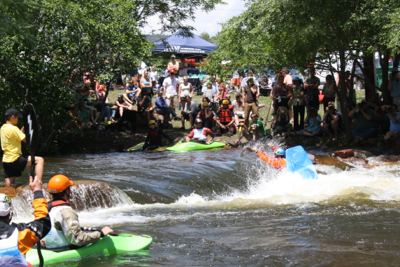The St. Vrain River near Lyons, Colorado is a highly utilized stretch of water. The reach sees considerable fishing and significant in-stream usage in the form of tubers, kayakers, and rafters.
 The reach includes many man-made recreational structures and is currently stocked with an experimental trout species by the Colorado Division of Wildlife. Additionally, this reach features several man-made structures that prevent the natural migration of in-stream species and also act as in-stream hazards to safe navigation. The St. Vrain River Fish Passage and Navigation Improvement Master Plan Study is tasked with examining a three-mile stretch of the St. Vrain near Lyons, Colorado to identify these man-made structures, and evaluate potential improvements that will enhance fish passage and in-stream habitat. Such improvements will also enhance safe navigation downstream. The study will create a master plan for these improvements and will provide conceptual design solutions that have been proposed and evaluated through detailed meetings with stakeholders and agencies. The deliverables for this study will include a report detailing information gathered and conclusions reached as well as conceptual level design solutions, costs estimates, and suggested avenues for project implementation.Background:
The project reach extends from the City of Lyon’s diversion located just upstream of the Apple Valley Bridge downstream to the Cemex Plant’s Diversion located just downstream of the junction of Hwy. 36 and Hwy. 66.
The reach includes many man-made recreational structures and is currently stocked with an experimental trout species by the Colorado Division of Wildlife. Additionally, this reach features several man-made structures that prevent the natural migration of in-stream species and also act as in-stream hazards to safe navigation. The St. Vrain River Fish Passage and Navigation Improvement Master Plan Study is tasked with examining a three-mile stretch of the St. Vrain near Lyons, Colorado to identify these man-made structures, and evaluate potential improvements that will enhance fish passage and in-stream habitat. Such improvements will also enhance safe navigation downstream. The study will create a master plan for these improvements and will provide conceptual design solutions that have been proposed and evaluated through detailed meetings with stakeholders and agencies. The deliverables for this study will include a report detailing information gathered and conclusions reached as well as conceptual level design solutions, costs estimates, and suggested avenues for project implementation.Background:
The project reach extends from the City of Lyon’s diversion located just upstream of the Apple Valley Bridge downstream to the Cemex Plant’s Diversion located just downstream of the junction of Hwy. 36 and Hwy. 66.
This reach of the river is divided, at its upstream end, into two forks: The North and the South Forks of the St. Vrain. At its downstream end the two forks join and thus is known as the St. Vrain River. The entire reach of interest is located in Boulder County, CO. In a more formal description, the site is located in the SW ¼ of Section 18, T3N, R70W, NW ¼ of Section 20, T3N, R70W respectively, all in Boulder County. The site encompasses an area centered around the City of Lyons, a town with a population of roughly 2000 people (5000 if accounting for the surrounding areas). The City of Lyons has invested heavily in its tourism resources including several in-stream and streamside recreational structures and attractions. Additionally, the City of Lyons is working with the Colorado Division of Wildlife to provide and regulate catch and release fishing—a popular activity for visitors to the Town. The economic impact of these in-stream recreational activities cannot be understated for the City of Lyons. These activities provide for a large part of the city’s businesses and annual budget. Similar towns, such as Vail, Breckenridge, Salida, Golden and Steamboat Springs, with similar river attractions, have shown significant economic impacts—on a per year basis—of several million dollars. Lyons, which already hosts a significant outdoor event, stands to derive this type of benefit. The structures located in this reach are in various states of repair. Some are actively maintained and utilized and some are failed or unused structures. This study proposes to evaluate alternatives at each of these structures through an extensive stakeholder process to find solutions that promote fish passage and improve in-stream navigation. Updating these structures has the potential to create more efficient water delivery for the intended water users at all water levels, reduce maintenance costs, improve the safety of recreational boaters, and improve the fishery by allowing safe passage aquatic species both up and down the river corridor during critical time periods such as the spawning season and winter migrations.
